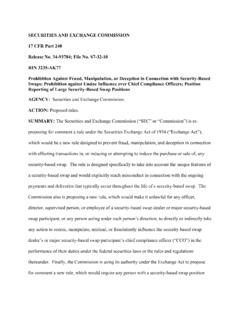Transcription of Investment Banking current and future challenges and changes
1 Investment Banking current and future challenges and changes03 current and prospective industry challenges , changes , disruptionsDon t react to changeCreate and prospective industry challenges , changes , disruptionsCurrent and prospective industry challenges , changes , disruptions 05 The Financial Services industry catches FinTech fever 07 The future of the Investment Banking landscape 09 Linking our unique African integrated offerings 11 current and prospective industry challenges , changes , disruptions05 The challenge for the Investment Banking industry revolves around higher capital charges, market electronification & digialisation, stuck cost base, inflexible and layered technology with increased complexity of regulation and Regulation drives business behaviourBanks are already fully engaged in meeting the IFRS 9 requirements and the resulting changes to their business model with specific focus on provisioning.
2 Pressure to build appropriate models and data requirements only leads to greater III has increased focus on maintaining core liquidity and leverage ratios with pressure on reducing short- term funding, holding more liquid assets, raising long-term wholesale funding, while reducing leverage both on and off balance sheet. is scarceThe effect of Basel III has resulted in fundamental shifts in product profitability. Structured derivatives and long dated transactions pre-crisis & Basel 3 in many cases are now a drag on ROE.
3 This has resulted in the shift towards the creation of non-core divisions to dispose of unprofitable transactions & portfolios. Commoditised exchanged traded OTC products has resulted in a fundamental change in margins and capital on costs as suboptimal ROE bites Investment banks face significant pressure to reduce their cost base as regulation has bitten. Industry experts predict only 5 to 6 Investment banks will be successful as transformational cost initiatives fail to deliver results on the back of complex infrastructure and governance are required to utilise their customer knowledge to not only retain but grow their customer returns through more effective cross ability to measure and cross sell products has become increasingly important to a company s ability to remain competitive.
4 While best servicing all bank customers with an eye on capital emergence of Fintech companies creates a disruptive marketplaceThe African financial services market is expected to be one of the most receptive FinTech markets globally, opening the door to disruption across the end to end Investment Banking value chain. Blockchain is rapidly seen as changing the face of cross - border lending , inflexible physical infrastructure restricts movement and growth in the current digital ageThe traditional infrastructure of banks (both physical and technical)
5 Has proven to be inflexible to change and this renders their ability to survive as is in a disruptive marketplace potentially and prospective industry challenges , changes , disruptions current and prospective industry challenges , changes , complexity of reporting and responding to new and evolving regulation with focus on data optimisationThe evolving demand for reporting compliance including governance outlined in BCBS 239 & Pillar 3 poses new challenges to all banks. This increases the pressure on data optimisation through accuracy, timelines & granularity of risk & financial reporting client onboarding conundrum The increased pressure for banks to both historically clean up their adherence to AML and KYC and remediate & streamline their current procedures.
6 The cost of compliance continues to rise with higher capital requirements resulting in the review of existing business model both geography and client is ripe in all financial markets Disruption in markets such as foreign exchange is reshaping the Banking landscape and how the traditional players exist in the ever-changing landscape with decreased market share and Place Lenders Securitising consumer debt as the challenge to raise funding to match new lending activity with 90% of fees from new loans with increased financing from Institutional investors.
7 Regulators push for greater transparency indicating disclosures. A bubble in the making in the current low interest-rate environment? Security Number of cases of digital theft from Banks through bypassing risk controls within Swift. Swift processes $6tn transfers daily with 11 000 members. EBA to stress test financial institutions to assess vulnerability to hackers & Swift to implement two factor authentication. get tough on BCBS 239 A number of regulators globally are now seeing adherence to meeting BCBS239 as a compliance requirement as opposed to set of principals.
8 This has resulted in considerable Investment cost to meet the current deadlines. Watch this and prospective industry challenges , changes , disruptions FinTech heralds the dawn of narrow Banking and portfolio optimisation. It will change the nature of money, shake the foundations of central Banking and deliver nothing less than a democratic revolution for all who use financial services. Mark Carney, governor of the Bank of EnglandAnnual global Investment in the FinTech industry has grown by a factor of multiples in the past 5 years, representing a compounded annual growth rate of 45%.
9 Goldman Sachs, Citi and Santander were the most active investors among the large banks. Central banks have also entered the fray with the Singaporean central bank funding a Blockchain-based record-keeping system as part of a five-year $225m Investment , the Canadian Central Bank announcing it is working with the country s largest banks to develop an electronic version of the Canadian dollar and the Bank of England s intent to use Blockchain and a digital central bank currency to widen access to its real-time gross settlement system (RTGS), which processes 500bn worth of transactions each day.
10 The Financial Services industry catches FinTech feverAnnual Global VC Investment in FinTechSource: Deloitte analysis on CB insights dataInvestment (Billions)Number of deals20113194405537017752012201320142015 $ $ $ $ 7. 3 0$ and prospective industry challenges , changes , disruptionsCurrent and prospective industry challenges , changes , disruptions09 The changes and evolution of the financial services landscape that we have seen to date is just the beginning of an ever-developing eco-system. Success in this new environment will force changes in the way financial institutions see themselves and their customers, the way in which they tailor and channel pioneering products, and the innovative strategies they use to combat new disruptors.
















